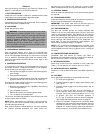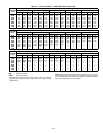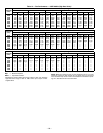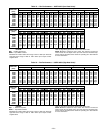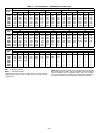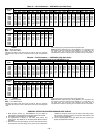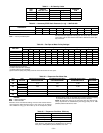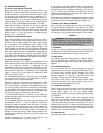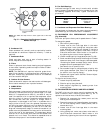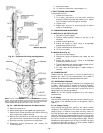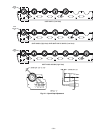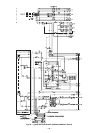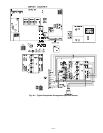
—34—
XIII. OPERATING SEQUENCE
A. Cooling, Units Without Economizer
When thermostat calls for cooling, terminals G and Y1 are
energized. The indoor (evaporator) fan contactor (IFC), com-
pressor contactor no. 1 (C1) and outdoor-fan contactor (OFC)
are energized, and evaporator-fan motor, compressor no. 1,
and both condenser fans start. The condenser-fan motors run
continuously while unit is cooling. If the thermostat calls for
a second stage of cooling by energizing Y2, compressor con-
tactor no. 2 (C2) is energized and compressor no. 2 starts.
When the thermostat is satisfied, C1 and C2 are deener-
gized and the compressors and outdoor (condenser) fan
motors (OFM) shut off. After a 30-second delay, the indoor
(evaporator) fan motor (IFM) shuts off. If the thermostat fan
selector switch is in the ON position, the evaporator-fan
motor will run continuously.
B. Heating, Units Without Economizer
When the thermostat calls for heating, terminal W1 is ener-
gized. In order to prevent thermostat short-cycling, the unit
is locked into the Heating mode for at least 1 minute when
W1 is energized. The induced-draft motor (IDM) is then
energized and the burner ignition sequence begins. The
indoor (evaporator) fan motor (IFM) is energized 45 seconds
after a flame is ignited. On units equipped for two stages of
heat, when additional heat is needed, W2 is energized and
the high-fire solenoid on the main gas valve (MGV) is ener-
gized. When the thermostat is satisfied and W1 and W2 are
deenergized, the IFM stops after a 45-second time-off delay.
C. Cooling, Units with EconoMi$erIV
When free cooling is not available, the compressors will be
controlled by the zone thermostat. When free cooling is avail-
able, the outdoor-air damper is modulated by the
EconoMi$erIV control to provide a 50 to 55 F supply-air tem-
perature into the zone. As the supply-air temperature fluctu-
ates above 55 or below 50 F, the dampers will be modulated
(open or close) to bring the supply-air temperature back
within the set point limits.
For EconoMi$erIV operation, there must be a thermostat
call for the fan (G). This will move the damper to its mini-
mum position during the occupied mode.
Above 50 F supply-air temperature, the dampers will modu-
late from 100% open to the minimum open position. From
50 F to 45 F supply-air temperature, the dampers will main-
tain at the minimum open position. Below 45 F the dampers
will be completely shut. As the supply-air temperature rises,
the dampers will come back open to the minimum open posi-
tion once the supply-air temperature rises to 48 F.
If optional power exhaust is installed, as the outdoor-air
damper opens and closes, the power exhaust fan will be ener-
gized and deenergized.
If field-installed accessory CO
2
sensors are connected to the
EconoMi$erIV control, a demand controlled ventilation
strategy will begin to operate. As the CO
2
level in the zone
increases above the CO
2
set point, the minimum position of
the damper will be increased proportionally. As the CO
2
level
decreases because of the increase in fresh air, the outdoor-air
damper will be proportionally closed. Damper position will
follow the higher demand condition from DCV mode or free
cooling mode.
Damper movement from full closed to full open (or vice
versa) will take between 1
1
/
2
and 2
1
/
2
minutes.
If free cooling can be used as determined from the appropri-
ate changeover command (switch, dry bulb, enthalpy curve,
differential dry bulb, or differential enthalpy), a call for cool-
ing (Y1 closes at the thermostat) will cause the control to
modulate the dampers open to maintain the supply air tem-
perature set point at 50 to 55 F.
As the supply-air temperature drops below the set point range
of 50 to 55 F, the control will modulate the outdoor-air damp-
ers closed to maintain the proper supply-air temperature.
D. Heating, Units With EconoMi$erIV
When the room thermostat calls for heat, the heating con-
trols are energized as described in the Heating, Units With-
out Economizer section. When the indoor fan is running, the
economizer damper moves to the minimum position. When
the indoor fan is off, the economizer damper is fully closed.
SERVICE
I. CLEANING
Inspect unit interior at beginning of each heating and cool-
ing season and as operating conditions require. Remove unit
top panel and/or side panels for access to unit interior.
A. Main Burner
At the beginning of each heating season, inspect for deterio-
ration or blockage due to corrosion or other causes. Observe
the main burner flames. Refer to Main Burners section on
page 37.
B. Flue Gas Passageways
The flue collector box and heat exchanger cells may be
inspected by removing heat exchanger access panel (Fig. 4-
6), flue box cover, and main burner assembly (Fig. 10 and
11). Refer to Main Burners section on page 37 for burner
removal sequence. If cleaning is required, remove heat
exchanger baffles and clean tubes with a wire brush.
Use caution with ceramic heat exchanger baffles. When
installing retaining clip, be sure the center leg of the clip
extends inward toward baffle. See Fig. 37.
C. Combustion-Air Blower
Clean periodically to assure proper airflow and heating effi-
ciency. Inspect blower wheel every fall and periodically
during heating season. For the first heating season,
inspect blower wheel bi-monthly to determine proper clean-
ing frequency.
To inspect blower wheel, remove heat exchanger access
panel. Shine a flashlight into opening to inspect wheel. If
cleaning is required, remove motor and wheel assembly by
removing screws holding motor mounting plate to top of
combustion fan housing. The motor and wheel assembly will
slide up and out of the fan housing. Remove the blower wheel
from the motor shaft and clean with a detergent or solvent.
Replace motor and wheel assembly.
D. Evaporator Coil
Clean as required with commercial coil cleaner.
WARNING: Before performing service or mainte-
nance operations on unit, turn off main power switch
to unit and install lockout tag on disconnect switch.
Electrical shock could cause personal injury.



